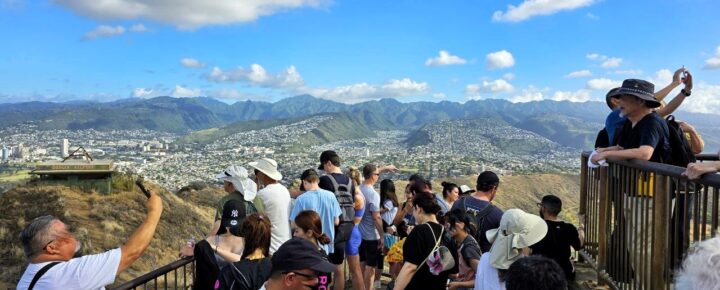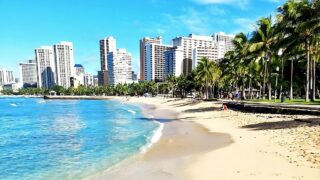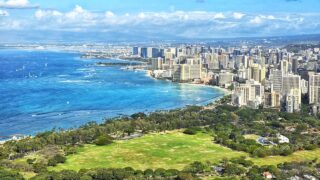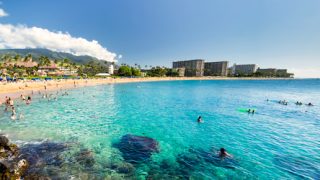Hawaii is at a turning point, and 2025 may redefine what it means to visit the islands. Airline shakeups, rising costs, and a controversial government strategy of welcoming fewer but higher-spending visitors have created uncertainty for travelers and residents alike. Yet, amidst these challenges lies an opportunity to rethink how—and when—you visit Hawaii.
Decades of observing Hawaii’s tourism trends reveal one constant: change. While accessing the islands may have become more challenging, careful planning can unlock the magic that makes Hawaii an unparalleled destination.
Airlines pull strings with Hawaii flights.
Flying to Hawaii in 2025 will present new challenges as airlines reduce flights, move to more narrow-body’s, and prioritize profitability. The Hawaiian Airlines merger with Alaska Airlines already has resulted in significant route changes, and it is just the beginning. Meanwhile, Southwest Airlines has announced it will scale back its Hawaii services, leaving budget-conscious travelers with fewer options.
Airlines are responding to a shifting market where fewer economy seats allow them to generate higher revenues—a bold strategy for travelers still seeking affordable fares.
A BOH reader, Chris, shared: “Hawaii flights used to be affordable if you timed it right. Now it feels like the good deals are disappearing altogether.”
To navigate this new reality, booking Hawaii flights early—or, in rare cases, very last minute—remains key. Also, keep an eye on new routes and more competitive mainland airports as airlines recalibrate their Hawaii networks throughout 2025.
Hawaii wants fewer visitors—and bigger spenders.
The state has made its goals clear: attract fewer visitors who spend more, and thus reduce strain on natural and cultural resources and communities. This strategy includes visitor fees, entry restrictions, and high-profile changes like eliminating short-term rentals in certain areas.
We’ve analyzed the state’s push for fewer visitors from several angles, including its triple bet on visitor fees, fewer rentals, and sports tourism and the rising cost of Hawaii vacations.
For some, all of these changes feel exclusionary. Kim shared: “It’s like Hawaii wants people to visit, but only if they’re spending luxury dollars. Regular families are getting priced out.”
Spring and fall shoulder seasons, for now, remain the best windows for travelers seeking more affordable trips with fewer crowds. However, visitors must now budget extra fees, such as parking, resort charges, and permits for places like Hanauma Bay or Kauai’s epic north shore.
Overtourism backlash or quiet beaches?
Despite Hawaii’s efforts to reduce overtourism, 2025 brings mixed signals. Visitor numbers have yet to rebound fully, and Maui’s wildfire recovery has added more complexity. While some residents push for stricter limits on tourism, others recognize the economic cost of fewer arrivals to Hawaii residents and local businesses.
John, a frequent visitor, wrote: “I’ve always loved the quieter side of Kauai, but even there, you can feel the tension. I understand the need to preserve the islands, but it’s starting to feel unwelcoming.”
The state’s evolving approach has led to reservations for places like Diamond Head, entry fees at some state parks, and adds to reduced availability of budget accommodations. But this also presents opportunities for visitors willing to explore less crowded areas, such as Polihale Beach on Kauai or the Big Island’s Papakōlea Beach. Here’s how these changes fit into the larger context of Hawaii’s tourism policies.
Sustainable travel will take center stage in 2025.
Hawaii’s shift toward sustainable tourism is reshaping how visitors experience the islands. Green-certified resorts, guided cultural tours, and eco-conscious travel practices are becoming much more the norm.
Jessica shared: “I’m happy to travel responsibly, but the rising costs make me wonder if Hawaii is pricing out the people who care most.”
For travelers in 2025, planning ahead will be essential. Popular sites like Haleakala’s sunrise and other epic adventures statewide require reservations months in advance.
Key takeaways for 2025 Hawaii travel.
- Timing matters more than ever. Spring and fall shoulder seasons offer better prices, fewer crowds, and ideal weather. Use Google flight alerts to start early and plan around reasonable costs for flights and hotels.
- Airline changes are here to stay. Book early and stay flexible as airlines adjust routes and reduce availability of some nonstop flights and economy seats.
- Budget carefully. Extra charges for accommodations, taxes, fees, parking, and permits will significantly impact Hawaii travel costs in 2025.
Hawaii travel in 2025 will demand more thought and preparation than ever. However, for those willing to adapt and plan, the rewards of visiting what remains our unparalleled tropical yet domestic destination remain as incredible as always.
Get Breaking Hawaii Travel News







I agree with John’s comment.
On Maui last October, our family of 6 all felt that there was less Aloha , less friendliness, less welcoming. Sad to say this, as it’s my happy place.
My wife and I have been to Oahu numerous times. Usually accompanied by family. We try to add more days each time we return. This coming year, 2025, we are returning with a brother and sister in-law. They are celebrating 40 yrs of marriage as we are. They will stay a week and we will be there 28 days. We plan to give back this yrs by working with the church soup kitchen. We love the island, but it is getting more costly. Being retired makes it tougher but with good planning and lots of prayers, we look forward to every trip we make. It’s about the love we have for the people and the activities that can never be duplicated anywhere else.
I am glad I visited Hawaii for the first time in 1986. Parked at the trailhead for Na Pali Coast – no crowds, no reservations, no parking fees
Same on Oahu- you went when you wanted without a regimented itinerary.
Regarding the State wanting only high-spending visitors. Hotels are not owned by the State. Once numbers drop, hotels will chase guests by offering discounts. That has been the case for the 30 years I have worked in hotels. However, as long as guests pay $500+ per night for an average hotel with reduced services and hotels are 70% or more occupied, why would anyone offer discounts?
We are going to Big Island in a week from Oregon. Flight on Alaska was cheapest ever. Car rental was cheapest in 5 years. Condos prices were down and abundant a month out. Maybe try BI instead of the other islands. Read the book Big Island Revealed because beaches are harder to find but also have less people. Will need to drive not walk to most beaches. Rent a convertible through Costco and have a fun time.
For the last 15 years our family has spent three weeks each year in Hawaii over the holidays. The last 2 years we have moved our annual trip to Tahiti. We get twice the value and spend about a third less. Tahiti and it’s islands are what people experienced in Hawaii in the 50’s. Less hassle, more natural beauty, and especially what has gone missing in the last 5 years… A welcoming Aloha spirit. I write this from a lounger overlooking a pool and the turquoise waters of the Moorea lagoon. Our family has found its new vacation home. I hope that Hawaii can find a balance some day before it is too late.
Awesome tip! Heading to Oahu next week and BI the week following.
Maybe the next tourist that Hawaii wants would be Elon Musk’s robots. Please pick the white or silver shelled versions. Have them gladly display the Aloha Spirit.
Political views should no be on this site
Just how is a robot a political statement? Did it attend a Taylor Swift concert? 🙂
Anyone notice that Walmart hit their latest financials out of the ballpark? Reason expressly given? Financially stressed wealthy shoppers are going down market and migrating en mass to shop their stores leaving high end chains such as Whole Paycheck Foods and foregoing bragging rights to try and save a buck.
Takes a lot of moola to maintain that “Keep up with the Jones'” lifestyle ya know, and a lot of those folks are being financially pressured like everyone else by high prices, stagnated income, and maxed out credit cards.
Be interesting to see how long high Hawaiian tourism prices will last in the face of an (already ongoing) recession and affluent consumers who have snapped their pocket books shut….
I agree Jay-
Even Target shoppers have downgraded. Target stock tanked 20% on Friday after reporting massive sales declines.
Also, about 20% of cars in California have expired license plate tags. People can’t afford car insurance, no insurance =no DMV renewal allowed. Sad
I’ve been visiting Hawaii every year for the last 12 years. But fall of 2024 was my last visit. But now it’s just too expensive, especially for Canadians like me. I should be the kind of visitor Hawaii says it wants, appreciative of Hawaiian culture, dedicated to supporting local businesses, and respectful of the islands’ environment. But I’m not rich. The state’s strategy of catering only to wealthy tourists makes me feel unwelcome and has priced me out of coming there.
Sadly the ones who support locals are the ones they are eliminating. Fellow Canadian who feels the same as you.
Oh yeah, I can see these “big spenders” elbowing the hoi-polloi out of the way to get on the guided cultural tours and eco-conscious field trips.
“Hey Elon, come quick. We got you a seat on Kimo’s Kulcha Jeepney.”
Spare me…
I have just finished organizing our 2025 Hawaii trip and am happy I followed a lot of your good advice!
We’ve enjoyed fall trips for years as it is definitely a lower visitor-count and cost part of the year. We’re also lucky as we’ve done all the “must do” activities so can pick and choose only the ones we feel like doing.
I convinced my friends that Premium Economy at $700 each way was a much better value than first class at $2,100, used Google Flights to optimize our island sequencing, and re-rented directly from vacation rentals we enjoyed on previous trips to save on fees.
And luckily I suffer from car rental OCD so play the rate game on Costco Travel all the way to rental time!
Yup we’ve already booked our 2025 trip to Hawaii. We just were there last month and are going again in 13 weeks! We prefer earlier in the year as we found out last month. The best part is it’s gonna cost just a few hundred more for 5 more nights than this last visit!!!
First visit we stayed 3 nights, 4 days. Second trip last month was 4 night, 5 days. When we go again gete soon it’ll be 9 nights and 10 days! Can’t wait!
For the first time in 13 years we did not go to Hawaiʻi for our fall trip. We just returned from our first ever trip to the Caribbean instead. We spent a week on Curaçao snorkeling and visiting different beaches. The snorkeling was better than anywhere we’ve snorkeled in Hawai‘i and the beaches were just as good if not better due to the smaller crowds.
Easier to get to, shorter and cheaper flights, and cheaper accommodations made for a great vacation. We missed Hawaiʻi, but didn’t miss the unwanted feeling we’ve felt on our last few trips. Everyone was friendly and welcoming like it used to be in Hawai‘i.
Mahalo, BOH!
The airlines, the hotels, and the government are all to blame. They’re working together to make Hawaii an exclusive playground for the rich while pushing out everyone else.
Once the government outlawed vacation rentals the hotel prices shot up through the roof. Vacation rentals were always a great way to visit Hawaii. Better accommodations, room for everyone without being cramped in a hotel room, and all in all just a more pleasurable experience. When VRs became a popular option the hotels were losing business to the mom and pop rentals at a rapid pace. The big corporations were losing money to them so of course they began to disappear, especially on Oahu. It’s so obvious what occurred. The hotel unions and lobby have finally got what the big corporations wanted, more of the visitor dollars, and these days they are Big dollars!
I love Hawaii dearly and have been visiting for decades, but it’s just not the same anymore. The aloha spirit feels like it’s disappearing, and visitors are treated like an inconvenience.
If I’m spending total luxury prices, I’d rather go to Europe or the Maldives frankly. Hawaii used to feel unique and welcoming at a more reasonable cost, but now it’s like they don’t even want us.
2025 will definitely define if Hawaii (Kauai) can still be my home away from home. I had already booked my 2025 ten week stay back in 2023. This will be my 50 year anniversary of my first visit in ’75. I also lived there from ’82 thru ’86. I love the people and aloha spirit I still receive on Kauai and will be heartbroken and sorely miss my yearly visit. But like many have commented, it seems us, the regular middle class, are being shelved for the big spending clientele. I only hope that the type of visitor Hawaii is trying to attract, will show the same care and respect that the Islands deserve.
This fewer visitors paying more strategy doesn’t work for locals like me. Tourism funds so much of our economy, and cutting down visitor numbers just makes things harder for us residents.
You are correct Kimo. If you have a hotel with 1000 rooms and they are filled, it will take ‘X’ number of people to clean and maintain. If you only sell 500 rooms but at twice the 1000 rooms rate, you still make the same amount of money but need less people to clean and maintain. The dollar amount coming in maybe the same, but the requirement for workers will be less and that is not good for our local economy.
Hawaii’s government shot itself in the foot. Fewer visitors mean less money for local businesses, and they’re the ones who will suffer the most.
Fewer economy seats? Great news for the airlines, terrible for travelers. I used to count on Southwest’s deals, but now even those seem have completely disappeared.
I get the clear need to protect the islands, but charging more for everything just feels like a money grab. Visitors are being nickel-and-dimed at every turn. We aren’t sure we’re returning.
Hawaii is pricing itself out of reach for the average family like mine. Between airfare, resort fees, and activity costs, it’s becoming impossible for us to justify another trip.